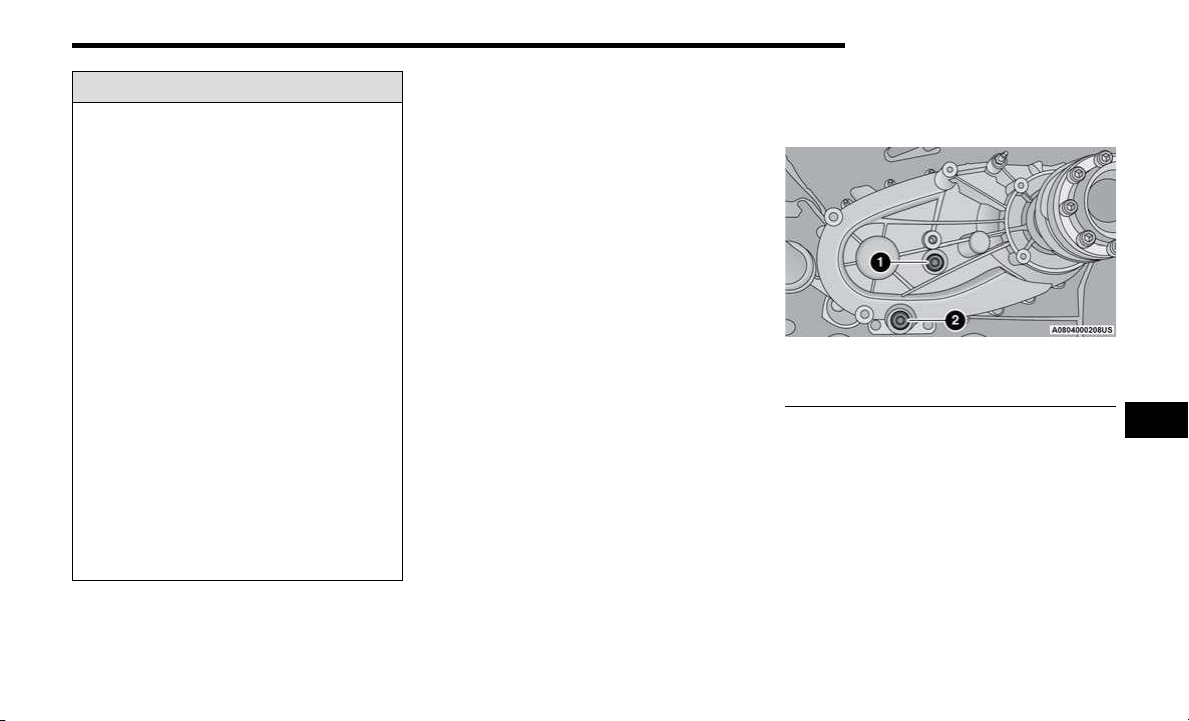Loading ...
Loading ...
Loading ...

SERVICING AND MAINTENANCE 257
FRONT/REAR AXLE FLUID
For normal service, periodic fluid level checks are not
required. When the vehicle is serviced for other reasons
the exterior surfaces of the axle assembly should be
inspected. If gear oil leakage is suspected inspect the fluid
level. Refer to “Fluids And Lubricants” in “Technical
Specifications” for further information.
Fluid Level Check
Lubricant should be approximately 1/8 inch (3 mm) below
the bottom edge of the oil fill hole.
NOTE:
Make sure that the vehicle is level and supported by the
axles
Adding Fluid
Add lubricant only at the fill hole and only to the level
specified above.
Selection Of Lubricant
Use only the manufacturer's recommended fluid. Refer to
“Fluids And Lubricants” in “Technical Specifications” for
further information.
TRANSFER CASE
Selection Of Lubricant
Use only the manufacturer's recommended fluid. Refer to
“Fluids And Lubricants” in “Technical Specifications” for
further information.
Fluid Level Check
The fluid level should be to the bottom edge of the fill hole
when the vehicle is in a level position.
Transfer Case
Drain And Refill
Refer to the “Maintenance Plan” in this section for the
proper maintenance intervals.
MANUAL TRANSMISSION
Selection Of Lubricant
Use only manufacturer's recommended manual
transmission fluid. Refer to “Fluids And Lubricants” in
“Technical Specifications” for further information.
WARNING!
Use only manufacturer's recommended brake fluid.
Refer to “Fluids And Lubricants” in “Technical Speci-
fications” for further information. Using the wrong
type of brake fluid can severely damage your brake
system and/or impair its performance. The proper
type of brake fluid for your vehicle is also identified
on the original factory installed hydraulic master
cylinder reservoir.
To avoid contamination from foreign matter or mois-
ture, use only new brake fluid or fluid that has been
in a tightly closed container. Keep the master
cylinder reservoir cap secured at all times. Brake
fluid in a open container absorbs moisture from the
air resulting in a lower boiling point. This may cause
it to boil unexpectedly during hard or prolonged
braking, resulting in sudden brake failure. This could
result in a collision.
Overfilling the brake fluid reservoir can result in
spilling brake fluid on hot engine parts, causing the
brake fluid to catch fire. Brake fluid can also damage
painted and vinyl surfaces, care should be taken to
avoid its contact with these surfaces.
Do not allow petroleum based fluid to contaminate
the brake fluid. Brake seal components could be
damaged, causing partial or complete brake failure.
This could result in a collision.
1 — Fill hole
2 — Drain hole
7
20_JL_OM_EN_USC_t.book Page 257
Loading ...
Loading ...
Loading ...